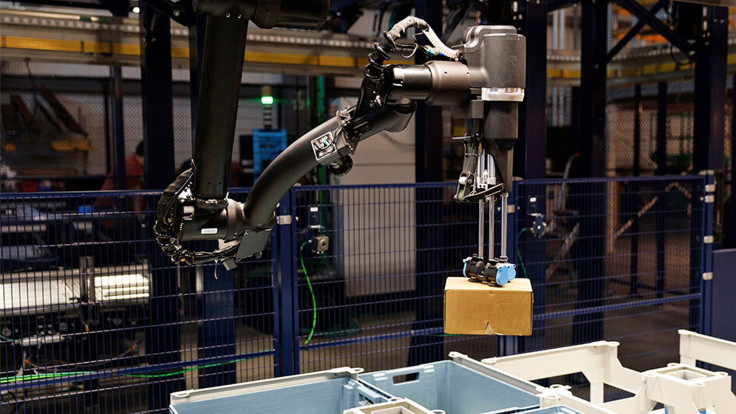Amazon's New 'Blue Jay' Robot Sparks AI Fear: The Truth Behind the Machine That Could Replace Humans
Amazon claims it's improving worker safety and creating 'more rewarding' roles

A new mechanical worker has landed in Amazon's warehouses, and it's stirring up an old fear: are our jobs safe?
Amazon's 'Blue Jay' robot, an advanced piece of machinery powered by artificial intelligence, is designed to glide across the floor, identifying, lifting, and moving items with impressive speed and accuracy.
Blue Jay: The Multi-Tasking Robot That Changes the Warehouse
The technology is astounding, but it carries a heavy implication. Is the 'Blue Jay' a fantastic new tool to help humans, or the beginning of an automated workforce that could make thousands of human roles obsolete?
On Wednesday, Amazon introduced a new automated system engineered to handle several different tasks simultaneously across the company's warehouses.
Meet Blue Jay, our next-generation robotic system that's like having an extra set of hands for our teams 🤖. It picks, stows, and consolidates in one streamlined workspace—moving three separate stations into one. pic.twitter.com/UNxWcT8X9M
— Amazon (@amazon) October 22, 2025
The system, known as Blue Jay, consists of several mechanical arms hanging from an overhead track, much like a conveyor belt. These arms feature suction cups at the ends, allowing the machine to pick up and sort items of different shapes and sizes.
How Blue Jay Merges Three Jobs into One Streamlined System
Amazon explained in a blog post that Blue Jay merges 'what used to be three separate robotic stations into one streamlined workplace that can pick, sort, and consolidate in a single place.'
The company stated that the automated system aims to help staff with duties that are otherwise demanding, simultaneously achieving better productivity within a smaller physical area.
I rarely get to share the specific embodiments I work with every day, but I'm thrilled to finally see this one go public
— Pranay Thangeda (@pthangeda_) October 23, 2025
Meet Amazon's newest robotic system: Blue Jay! pic.twitter.com/55IGcbuace
Amazon is trialling Blue Jay at a warehouse in South Carolina, and initial results show the system can select, package, store, and bring together around 75 percent of the items kept at its facilities. Blue Jay is the latest addition to the increasing number of automated machines now operating throughout Amazon's numerous fulfilment centres.
Over the last few years, Amazon has launched various robots designed for distinct tasks, from taking products off shelves to organising parcels. For instance, in May, it introduced 'Vulcan', a robotic system equipped with a sense of touch.
Amazon's efforts to automate its warehouses really took off following its $775 million (£580.50 million) purchase of Kiva Systems back in 2012.
Preventing Hires: The 160,000 Jobs Amazon Hopes to Avoid
This new announcement comes as Amazon's reliance on automation in its warehouses faces heightened public scrutiny, particularly concerning the impact on its vast number of frontline staff.
On Tuesday, The New York Times released an investigation, based on internal strategy documents and interviews, which revealed that Amazon's automation group projects it can prevent the hiring of over 160,000 workers in the US by 2027, equating to a saving of roughly 30 cents on the cost of packing and delivering every single item.
Responding to the report, an Amazon spokesperson informed CNBC via email that the documents presented only an 'incomplete and misleading picture of our plans'.
The spokesperson added, 'In this instance, the materials appear to reflect the perspective of just one team and don't represent our overall hiring strategy across our various operations business lines — now or moving forward'.
Internal documents reported by The New York Times reveal that Amazon’s automation division projects it will eliminate the need to hire roughly 600,000 U.S. workers.
— Open Source Intel (@Osint613) October 21, 2025
Looks like it’s going to take sometime
🤣🤣🤣 pic.twitter.com/oxCSNLsuQc
While Amazon has claimed that greater automation could lead to improved worker safety and fewer injuries, this idea has been challenged. For example, a 2020 report from Reveal from the Center for Investigative Reporting showed that the company's warehouses using robots actually had higher injury rates than those without automated systems.
Last week, Amazon announced its intention to take on 250,000 employees for full-time and part-time positions during this year's holiday shopping season, matching the recruitment numbers of the previous two years.
As the nation's second-biggest private employer, Amazon's adopted automation strategy could signal future trends for both the broader job market and other major companies. Globally, the company had over 1.54 million staff at the end of the second quarter, a total that does not include delivery drivers, who are employed via external, third-party companies.
The $4 Billion Question: Automation, Savings and the Frontline Workforce
In a note published on Wednesday, analysts at Morgan Stanley estimated that the deployment of Amazon's automated warehouses, alongside reductions in labour and fulfilment expenses, could produce savings reaching $4 billion (£3 billion) by 2027.
On Wednesday, the company asserted that its employees will remain 'at the centre' of its robotics programme, stating its aim is to 'reduce physically demanding tasks, simplify decisions and open new career opportunities' for its workforce.
Amazon has attempted to stress how greater automation in its sites will allow staff to move into 'more rewarding' positions within the business. It offers an apprenticeship programme focused on mechatronics and robotics, which teaches skills needed to look after and monitor the machinery.
© Copyright IBTimes 2025. All rights reserved.






















